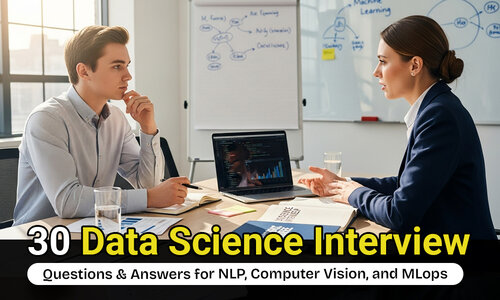30 Data Science Interview Questions & Answers for NLP, Computer Vision and MLOps
 By
By
The 30 data science interview questions discussed in this article are a research-based resource to help you excel in interviews. This guide aims to introduce you to the core data science domains. The knowledge and skills gained from this will help you excel in relevant interviews
Have you ever wondered how automated machines understand words, identify faces, and run entire AI systems? Data science is the answer to all those questions. It combines principles and practices from multiple scientific disciplines to analyse data of various forms and sizes. The aim is to make informed decisions, solve complex problems, and build predictive models. NLP, Computer Vision, and MLOps are specialised disciplines within data science that perform specific actions on data.
Did you know? The average Data Scientist salary in the UK ranges from £48,000 to £72,000, depending on location, sector, and experience. CV Library
Whether you are an expert in one of these disciplines or a beginner looking to land your first job, interview preparation is a must. The interviewer will ask top data science interview queries and technical questions to check your knowledge and skills. In this guide, we have prepared a list of 30 data science interview questions with real-life scenarios and explanations to help you excel in interviews.
What Sums it Up:
Data Science transforms raw data into a source of tangible value and strategic advantage. NLP, CV, and MLOps work together to make that happen.
Skills in these domains can make you a well-rounded candidate capable of delivering tangible business value.
The purpose of an NLP interview is to check if you can translate theoretical knowledge into effective real-world solutions.
MLOps interview questions are designed to evaluate your proficiency in managing the entire machine learning lifecycle.
You must have a grip on the Python programming language to score a clear edge in data science interviews.
Overview of Key Data Science Domains
Data science is a vast field with several foundational sub-domains, including computer science, statistics, and domain knowledge. NLP, MLOps, and Computer Vision are specialised application areas that combine these foundational sub-disciplines to solve specific real-world problems. Understanding these concepts can be challenging for students new to AI, especially when writing technical essays. This is why smart students rely on a UK essay writing service for guidance and examples.
Natural Language Processing (NLP)
NLP is a subfield of artificial intelligence that uses machine learning to comprehend, interpret, and produce human language in both textual and spoken formats. Businesses receive most of their data in an unstructured format, such as emails and reviews.
NLP unlocks the insights from this data and automates the process to ensure structured information continues to flow. NLP also help in qualitative data analysis by speeding up the process, and helping to mitigate bias through automated processing of large text volumes
Computer Vision
AI has come far enough to interpret and understand visuals just like humans do. This is possible through a subdomain of Artificial Intelligence called computer vision. It uses technologies such as machine learning, deep learning, and pattern recognition to identify objects. These technologies also help extract meaningful insights from the given visual data.
MLOps
Machine Learning Operations is an engineering discipline focused on unifying the development (Dev) of machine learning systems with their operations (Ops). It is an extension of DevOps that focuses on managing the entire machine learning model lifecycle.
Top 30 Data Science Interview Questions and Answers
From Python coding challenges to SQL questions for data scientists, candidates must be prepared for a variety of topics. Expect statistics interview questions, behavioural interview data science scenarios, and even case study questions for data science. You will also get supervised vs unsupervised learning questions and queries regarding Apache Kafka.
Here are the top 30 data science interview questions and answers to help you excel in your preparation.
Top NLP Interview Questions and Answers
-
What is the difference between a formal language and a natural language?
A formal language is a precisely defined set of rules used to build strings from a limited collection of characters. Its examples are all valid Python programs or mathematical equations that computers can process without ambiguity. Natural language is the language we use to communicate in our daily lives. It is completely different from a formal language. A natural language openly uses word fragments and pauses words like "uh" and "um," etc. -
What is tokenisation, and why is it important in NLP?
Tokenisation is the process of splitting running text into words and sentences. These smaller units are called tokens, and it is the first step in most NLP pipelines. Once converted, the computer can easily understand the data and perform processes like sentiment analysis and information retrieval. -
Explain the difference between stemming and lemmatisation.
Stemming and lemmatisation are keyword normalisation techniques aiming to minimise the morphological variation in the words they encounter in a sentence. Stemming removes the affixes attached to a word (Caring → Car). Lemmatisation converts a word into its lemma form (Caring → Care). -
What are word embeddings, and how are they used?
Word embedding in NLP is the process of representing textual data through real-numbered vectors. This method allows words that have similar meanings to have a similar representation. -
What are transformers, and why are they popular in NLP?
Transformers are a powerful neural network architecture that have revolutionised Natural Language Processing. They use a self-attention mechanism to process entire sequences of data simultaneously. Transformers are a significant update in speeding up NLP processes, as previous models could only process one word at a time. -
How do you handle out-of-vocabulary words?
OOV words are words that an NLP model encountered during training or real-world use, but are not present in the vocabulary or training data of a model.
● Use sub word tokenisation techniques like Byte Pair Encoding. This technique splits OOV words into smaller sub word units that are present in the vocabulary.
● Replace OOV words with a special token to indicate that they are unknown. -
Can you list a few real-world applications of the n-gram model?
● Augmentive Communication
● Parts-of-speech Tagging
● Natural language generation
● Word Similarity
● Authorship Identification
● Sentiment Extraction
● Predictive Text Input -
What is the role of Named Entity Recognition (NER) in NLP?
Named Entity Recognition is responsible for finding and labelling key information in the text.
● People
● Organisations
● Locations
● Dates
● Currency
This helps NLP models transform unstructured human language into structured data. The data can then be analysed or stored in a data warehouse. -
What are some challenges in training large language models?
● High computational costs
● The need for massive and high-quality datasets
● The difficulty of mitigating training data biases
● The ethical implications of their development and use -
What is TF-IDF and How Does It Work?
TF-IDF, short for Term Frequency–Inverse Document Frequency, is a statistical method used to evaluate how important a word is within a particular document compared to a larger collection of documents.
Term frequency is a count of how many times a word appears in a single document.
Inverse document frequency is a score that shows how rare a word is across a collection of documents.
Most Repeated Computer Vision Interview Questions and Answers
-
What are CNNs?
Convolutional Neural Networks are deep learning algorithms that do not require manual programming to recognise objects. CNNs or ConvNets interpret things just like a human does. Instead of examining an image pixel by pixel, CCNs use specialised digital lenses to scan an image for specific patterns. The best thing about CNNs is that they automatically recognise which features are important, eliminating the need for a human to manually program what a "cat's ear" looks like. -
How do pooling layers work in CNNs?
Pooling layers summarise the data collected by the convolutional layers into a smaller, more manageable format. The process involves sliding a window over the input and aggregating the values within that window.
● Max pooling (which takes the maximum value)
● Average pooling (which averages all values). -
Explain transfer learning in computer vision.
Transfer learning is a technique in which a model trained on a large dataset is used as a starting point for another relevant task. This ensures that the new model is trained quickly on pre-defined information and can move to the next phase. This is similar to how you can transfer your knowledge of painting into drawing. -
How does object detection differ from image classification?
Image classification assigns a label to an entire image. Object detection specifies the objects present in an image and assigns a label to each. The purpose of image classification is to categorise an image or object present inside it into one of several pre-defined classes. Object detection, however, applies a bounding box to each detected object within the image. -
What are popular object detection models like YOLO or Faster R-CNN?
Object detection models are a type of computer vision system designed to locate objects within an image. They also determine what kind of objects they are. YOLO (You Only Look Once) and Faster R-CNN (Faster Region-based Convolutional Neural Network) are two popular models with their unique capabilities.
YOLO looks at the whole picture at once to guess where things are. It is ideal for real-time applications that require instant decisions.
Faster R-CNN first spots the major areas of interest, and then takes a closer look. It is suitable for tasks that require precision. -
How do you handle class imbalance in image datasets?
An imbalanced dataset is one in which all classes are not represented equally. When handling such datasets, the goal is to ensure the model pays adequate attention to the underrepresented classes. Here are some ways to handle class imbalance:
● Data Augmentation
● Class Weighting
● Focal Loss
● Under sampling the Majority -
Explain the role of activation functions, such as ReLU, in CNNs.
The Rectified Linear Unit introduces non-linearity to deep learning models. Without them, a CNN could only learn simple, straight-line relationships, no matter how many layers it had. ReLU achieves this by allowing all positive values to pass and setting negative values to zero. -
What is translational equivariance? What brings about this property in Convolutional Neural Networks?
Translational equivariance is the property where shifting the input of a system results in a corresponding, identical shift in the output. If an object in an image moves a few pixels to the right, the neural network's output indicating the object's location also shifts a few pixels to the right, while the content of the detection remains unchanged. In Convolutional Neural Networks (CNNs), this crucial property is achieved through the use of parameter sharing. -
What purpose does grayscaling serve?
Grayscaling helps to reduce the dimension of the image and thus allows for reduced computation time and effort. Some functions, such as edge and contour detection, and machine learning problems, like Optical Character Recognition, perform better or are implemented to work only with grayscale images. -
What is a feature descriptor in computer vision?
A feature descriptor is a representation of an image region or keypoint. It captures distinctive information, like the appearance, shape, or texture of the region or objects within it. The feature descriptor is used to describe and match keypoints across images.
Best MLOps Interview Questions and Answers
-
What is MLOps, and how does it differ from DevOps?
Machine Learning Operations is a specialised extension of DevOps for machine learning models. MLOps manages the entire machine learning model lifecycle. DevOps involves application development and IT operations. The major difference between the two is that MLOps lifecycles are data-driven, while DevOps lifecycles are more focused on the. -
What is model or concept drift?
These terms refer to changes in the performance of machine learning models over time. Model and concept drifts occur due to evolving data patterns and underlying relationships. A model drift occurs when an ML model's performance deteriorates because the data it encounters in production deviates from the data it was trained on. Concept drift occurs when the relationship between input features and target variables changes. This drift can result in the model's predictions becoming less accurate. -
What are the main components of an MLOps pipeline?
A Machine Learning Operations pipeline is a structured and automated flow that includes the following stages:
● Data Ingestion
● Preprocessing
● Model Training
● Validation
● Deployment
● Monitoring
● Feedback Loops -
What testing should be done before deploying an ML model?
Testing in an ML model goes beyond standard software testing. The following comprehensive tests must be conducted:
● Unit testing
● Integration testing
● Performance testing
● Stress testing
● A/B testing
● Robustness testing -
Why is monitoring important in MLOps, and what metrics should you track?
The MLOps models that are deployed in the real time are not static. Their real-world performance naturally degrades over the time due to changes in the patterns of data. Effective monitoring ensures that the model remains reliable and continues to deliver business value. You must check for accuracy, precision, recall, and other performance indicators to detect model degradation. -
How does infrastructure as code (IaC) integrate with MLOps?
IaC allows infrastructure to be provisioned programmatically. Tools like Terraform automate the deployment and scaling of resources for training and inference. Doing so also promotes scalability and reproducibility. -
Can you explain CI/CD in the context of machine learning?
Continuous Integration/Continuous Delivery in ML is an automated approach that builds reliable, repeatable workflows. These workflows accelerate the transition of ML models from development to production. According to LockedInAi, 87% of data science projects never reach production, and 77% of businesses encounter hurdles in implementing big data and AI initiatives. -
What are the challenges of scaling MLOps across multiple teams or organisations?
Scaling MLOps across multiple teams or organisations comes with technical, operational, and organisational challenges:
● Managing multiple models
● Ensuring consistent standards
● Handling infrastructure diversity
● Aligning with security and compliance. -
Describe the role of feature stores in MLOps.
A feature store is a centralised storage for storing, managing, and serving data features to ML models. It processes data received from various sources simultaneously and converts it into features. The model training pipeline and the model serving then consume these features. -
How do you handle model rollback in case of deployment failure?
A well-thought-out rollback strategy is the one that minimises the downtime and restores normal operations quickly. The foundation of a good rollback process is strong version control. Every model version, along with its data and configuration, must be uniquely tracked. Tools like semantic versioning, Git commit hashes, or build IDs can help in this regard.
Conclusion
NLP, Computer Vision, and OOP are the three topics you must tighten your grip on for a successful data science interview. A well-rounded grip of these topics and probability questions in data science gives you an edge both logically and technically over other competitors. Expect to tackle data wrangling interview questions, which test your data cleaning and anomaly detection abilities. Preprocessing in data science is another critical area, particularly for roles that focus on machine learning.
Balancing interview preparation with academic responsibilities can be a hard nut to crack, so effective time management is essential. You can use the best essay writing service in the UK to manage your workload while focusing on key topics like feature engineering and neural networks, which are central to many interviews.
Frequently Asked Questions About Data Science Interview Questions
What case studies are used in data science interviews?
Data science interviews use modelling and business case studies. Modelling cases focus on how you would build and deploy a machine learning model. Analysis cases involve using data to provide business insights, such as analysing user behaviour, measuring feature adoption, or estimating the impact of a new feature or campaign.
What Python interview questions for data science are frequently asked?
Python interview questions for data science cover core Python concepts. Include such types of questions on data manipulation and applied machine learning. You can also be asked about handling the missing values or solving practical coding challenges.
Are there data science interview tips for freshers and experienced professionals?
The freshers should understand the differences between labelled and unlabeled data. They may also focus on supervised and unsupervised learning. The Experienced candidates can expect their profound discussions on the standard deviation and questions of the portfolio. Additionally, be ready for common HR questions that assess your problem-solving approach and team dynamics.






